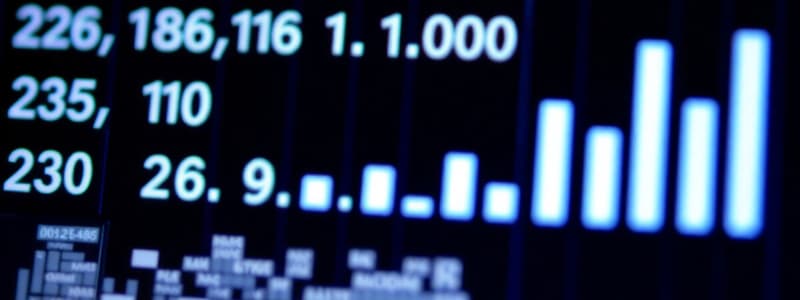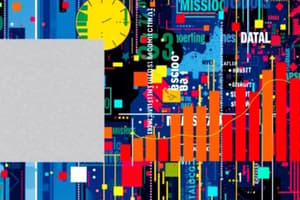Podcast
Questions and Answers
What are the two main categories of data that are described in the excerpt?
What are the two main categories of data that are described in the excerpt?
The two main categories are ordinal data and quantitative data.
Give two examples of how ordinal data is used.
Give two examples of how ordinal data is used.
Two examples of ordinal data are education level (elementary, middle, high school, college) and job position (manager, supervisor, employee).
What is the primary goal of managing outliers in a dataset?
What is the primary goal of managing outliers in a dataset?
The primary goal of managing outliers is to reduce their potential influence on data analysis, ensuring more accurate and reliable insights.
What is the difference between discrete and continuous data?
What is the difference between discrete and continuous data?
Explain the concept of 'missing at random' (MAR) data, providing an example.
Explain the concept of 'missing at random' (MAR) data, providing an example.
What kind of test is used to analyze ordinal data, and what is the reason behind using this type of test?
What kind of test is used to analyze ordinal data, and what is the reason behind using this type of test?
What is the difference between 'missing completely at random' (MCAR) and 'missing not at random' (MNAR) data?
What is the difference between 'missing completely at random' (MCAR) and 'missing not at random' (MNAR) data?
Give two examples of discrete data, as described in the excerpt.
Give two examples of discrete data, as described in the excerpt.
Describe a scenario where deleting rows with missing values might be a suitable solution. Explain why.
Describe a scenario where deleting rows with missing values might be a suitable solution. Explain why.
Identify two examples of continuous data based on the excerpt.
Identify two examples of continuous data based on the excerpt.
Why is handling missing data important for data analysis?
Why is handling missing data important for data analysis?
What type of visual representation is suitable for ordinal data, and why?
What type of visual representation is suitable for ordinal data, and why?
What are two strategies for handling missing data values besides deleting rows?
What are two strategies for handling missing data values besides deleting rows?
Explain the concept of imputing missing data values.
Explain the concept of imputing missing data values.
What distinguishes quantitative data from ordinal data?
What distinguishes quantitative data from ordinal data?
Why is it crucial to identify the type of missing data before choosing a handling method?
Why is it crucial to identify the type of missing data before choosing a handling method?
What is the primary goal of data cleaning in machine learning?
What is the primary goal of data cleaning in machine learning?
Why is data cleaning considered a crucial step in the machine learning pipeline?
Why is data cleaning considered a crucial step in the machine learning pipeline?
Explain the importance of removing unwanted observations during data cleaning.
Explain the importance of removing unwanted observations during data cleaning.
What are the main types of structural errors that need to be addressed during data cleaning?
What are the main types of structural errors that need to be addressed during data cleaning?
Why is it important to address structural errors in a dataset?
Why is it important to address structural errors in a dataset?
What is the significance of the statement 'Better data beats fancier algorithms' in the context of data cleaning?
What is the significance of the statement 'Better data beats fancier algorithms' in the context of data cleaning?
Describe the overall process of data cleaning, highlighting key steps.
Describe the overall process of data cleaning, highlighting key steps.
What are some potential consequences of neglecting data cleaning in machine learning projects?
What are some potential consequences of neglecting data cleaning in machine learning projects?
How is the missing value ratio calculated?
How is the missing value ratio calculated?
What advantage do embedded methods have over filter and wrapper methods?
What advantage do embedded methods have over filter and wrapper methods?
What role does regularization play in machine learning models?
What role does regularization play in machine learning models?
How does Random Forest Importance contribute to feature selection?
How does Random Forest Importance contribute to feature selection?
What is the most common method for merging datasets?
What is the most common method for merging datasets?
What is the significance of having a threshold value when dealing with missing data?
What is the significance of having a threshold value when dealing with missing data?
Explain the purpose of using penalty terms in regularization techniques.
Explain the purpose of using penalty terms in regularization techniques.
What does Gini impurity measure in the context of Random Forest?
What does Gini impurity measure in the context of Random Forest?
What is the primary difference between quantitative data and qualitative data?
What is the primary difference between quantitative data and qualitative data?
How can discrete data be visually represented compared to continuous data?
How can discrete data be visually represented compared to continuous data?
In what ways can discrete and continuous data be characterized?
In what ways can discrete and continuous data be characterized?
What role does a data source play in the context of data usage?
What role does a data source play in the context of data usage?
What is a database and what is its primary function?
What is a database and what is its primary function?
How does qualitative data typically manifest in research?
How does qualitative data typically manifest in research?
What is a key feature that differentiates grouped frequency distribution from ungrouped frequency distribution?
What is a key feature that differentiates grouped frequency distribution from ungrouped frequency distribution?
Explain how data can be utilized from different sources.
Explain how data can be utilized from different sources.
How does log transformation help in handling skewed data?
How does log transformation help in handling skewed data?
What is the purpose of binning in feature engineering?
What is the purpose of binning in feature engineering?
Explain feature split and how it benefits machine learning algorithms.
Explain feature split and how it benefits machine learning algorithms.
What does one hot encoding achieve in machine learning?
What does one hot encoding achieve in machine learning?
Define lagged variables in the context of time series forecasting.
Define lagged variables in the context of time series forecasting.
What are moving window statistics and their purpose?
What are moving window statistics and their purpose?
List some examples of time-based features and their significance.
List some examples of time-based features and their significance.
How does feature engineering contribute to solving overfitting in machine learning?
How does feature engineering contribute to solving overfitting in machine learning?
Flashcards
Quantitative data
Quantitative data
Data that can be expressed as numbers, such as ratios, percentages, or counts.
Qualitative data
Qualitative data
Data that describes qualities or characteristics, such as opinions, feelings, or descriptions.
Discrete data
Discrete data
Data that has distinct separate values, with gaps between them. It is countable.
Continuous data
Continuous data
Signup and view all the flashcards
What is a database?
What is a database?
Signup and view all the flashcards
What is a data source?
What is a data source?
Signup and view all the flashcards
What is a DBMS?
What is a DBMS?
Signup and view all the flashcards
Ordinal Data
Ordinal Data
Signup and view all the flashcards
Frequency Tests
Frequency Tests
Signup and view all the flashcards
Non-parametric Tests for Ordinal Data
Non-parametric Tests for Ordinal Data
Signup and view all the flashcards
Wilcoxon Signed-Rank Test
Wilcoxon Signed-Rank Test
Signup and view all the flashcards
Mann-Whitney U Test
Mann-Whitney U Test
Signup and view all the flashcards
Data Merging
Data Merging
Signup and view all the flashcards
Data Cleaning
Data Cleaning
Signup and view all the flashcards
Removal of Unwanted Observations
Removal of Unwanted Observations
Signup and view all the flashcards
Fixing Structure Errors
Fixing Structure Errors
Signup and view all the flashcards
Why is data cleaning important?
Why is data cleaning important?
Signup and view all the flashcards
Data Cleaning in ML
Data Cleaning in ML
Signup and view all the flashcards
Better data beats fancier algorithms
Better data beats fancier algorithms
Signup and view all the flashcards
Issues with raw data
Issues with raw data
Signup and view all the flashcards
Outliers
Outliers
Signup and view all the flashcards
Managing Outliers
Managing Outliers
Signup and view all the flashcards
Handling Missing Data
Handling Missing Data
Signup and view all the flashcards
Missing Completely At Random (MCAR)
Missing Completely At Random (MCAR)
Signup and view all the flashcards
Missing At Random (MAR)
Missing At Random (MAR)
Signup and view all the flashcards
Missing Not At Random (MNAR)
Missing Not At Random (MNAR)
Signup and view all the flashcards
Deleting Rows with Missing Values
Deleting Rows with Missing Values
Signup and view all the flashcards
Imputing Missing Values
Imputing Missing Values
Signup and view all the flashcards
Log Transform
Log Transform
Signup and view all the flashcards
Binning
Binning
Signup and view all the flashcards
Feature Split
Feature Split
Signup and view all the flashcards
One-Hot Encoding
One-Hot Encoding
Signup and view all the flashcards
Lagged Variables
Lagged Variables
Signup and view all the flashcards
Moving Window Statistics
Moving Window Statistics
Signup and view all the flashcards
Time-Based Features
Time-Based Features
Signup and view all the flashcards
Ordinal Encoding
Ordinal Encoding
Signup and view all the flashcards
Missing Value Ratio
Missing Value Ratio
Signup and view all the flashcards
Missing Value Threshold
Missing Value Threshold
Signup and view all the flashcards
Embedded Methods
Embedded Methods
Signup and view all the flashcards
L1 and L2 Regularization
L1 and L2 Regularization
Signup and view all the flashcards
Random Forest Feature Importance
Random Forest Feature Importance
Signup and view all the flashcards
Data Merging (Joining)
Data Merging (Joining)
Signup and view all the flashcards
Inner Join
Inner Join
Signup and view all the flashcards
Left Join (Left Outer Join)
Left Join (Left Outer Join)
Signup and view all the flashcards
Study Notes
T.Y.C.S. SEM-VI DATA SCIENCE
- Course compiled by Megha Sharma
- Available online at https://www.youtube.com/@omega_teched
Chapter 1: What is Data Science?
- Data science is the study of massive datasets, extracting insights from structured and unstructured data using scientific methods, technologies, and algorithms.
- It's a multidisciplinary field.
- Applications include:
- Image and speech recognition: Used in automatic tagging suggestions on social media and voice control in devices.
- Gaming: Enhancing user experience, such as in EA Sports, Sony, and Nintendo games.
- Internet: Improving search engine results, providing faster access to information.
- Transportation: Creating self-driving cars.
- Healthcare: Providing benefits like tumor detection, drug discovery, and medical imaging analysis.
- Recommendation systems: Personalized recommendations for products (e.g., Amazon) and services.
- Risk detection: Identifying fraudulent activities and risk of losses in Finance industries.
- Business intelligence (BI) vs. Data science: BI primarily focuses on structured data, like data warehouses, while Data Science can handle both structured and unstructured data, like weblogs and feedback.
Chapter 2: Data Types and Sources
- Data types:
- Structured data: Data organized in a formatted repository (e.g., database tables with rows and columns).
- Semi-structured data: Data with some organizational properties, but not as rigidly structured (e.g., XML, JSON).
- Unstructured data: Data lacking a predefined format or structure (e.g., text files, images, videos).
- Data sources:
- Databases
- Files (e.g., CSV, Excel)
- APIs
- Web scraping
- Sensors
- Social media
Chapter 3: Data Preprocessing
- Data cleaning:
- Handling missing values: Identifying and removing missing or irrelevant data.
- Techniques: constant values, Mean/median imputation, prediction models.
- Removing duplicates: Removing redundant data entries.
- Handling outliers: Identifying and addressing data points far from the norm.
- Techniques: winsorization, log transformation, imputation.
- Handling missing values: Identifying and removing missing or irrelevant data.
- Data transformation: Changing data format or structure.
- Feature selection: Choosing the most important variables for the model.
- Data merging: combining multiple datasets based on common columns
Chapter 4: Data Wrangling and Feature Engineering
- Data wrangling (data munging): Cleaning, organizing, and transforming data into a usable format.
- Reshaping data: Changing the structure of the dataset
- Techniques: Merging, melting, pivoting, data aggregation
Chapter 5: Tools and Libraries
- Popular libraries and technologies used in Data Science:
- TensorFlow: Machine learning and AI
- Matplotlib: Data visualization
- Pandas: Data manipulation
- NumPy: Numerical computing
- Scikit-learn: Machine learning models
- Scrapy: Web data extraction
Chapter 6: Exploratory Data Analysis (EDA)
- Techniques for understanding and summarizing data:
- Data Cleaning: Identifying and addressing missing values, inconsistencies, and outliers.
- Descriptive Statistics: Calculating measures like mean, median, mode, standard deviation, range.
- Data Visualization: Creating charts, plots, and other visualizations.
- Data Visualization Techniques: Using techniques like histograms, box plots, scatter plots, and heatmaps to visualize different distributions and relationships in the data.
- Correlation Assessment: Methods for determining the strength and direction of relationships between variables.
- Data Segmentation: Grouping and segmenting data based on observable characteristics.
- Hypothesis Generation: Forming hypotheses to guide further analysis.
- Data Quality Assessment: Evaluating the reliability, consistency, and validity of the data.
Chapter 7/8/9/10/11/12: Further Data Science Concepts
- Data Mining: Discovering patterns and relationships in large datasets.
- Data Warehousing: Storing and organizing data for analysis.
- Data Repositories: Centralized stores of data.
- One-Hot Encoding: Converting categorical variables into binary variables.
- Label Encoding: Converting categorical variables into numerical labels.
- Feature Scaling: Standardizing or normalizing feature values.
- Data Storytelling: Communicating data-derived insights in a clear and compelling narrative.
- Model Evaluation Metrics: Measuring the performance of statistical and machine learning models (e.g., accuracy, precision, recall, AUC, confusion matrix).
- Statistical Methods: Using statistical techniques to analyze and draw conclusions about the data (e.g., hypothesis testing, analysis of variance (ANOVA)).
- Visualization Tools in Data Science : Using various visualization tools for presenting data with rich insights (e.g., Matplotlib, Seaborn, Tableau, ggplot2).
Studying That Suits You
Use AI to generate personalized quizzes and flashcards to suit your learning preferences.




